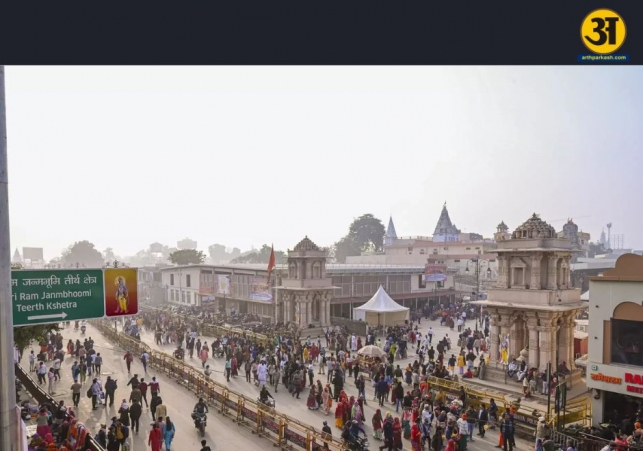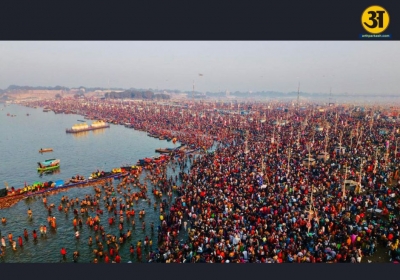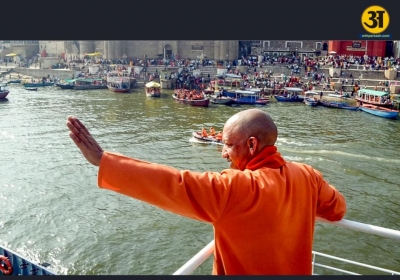
Ayodhya split into six zones for Maha Kumbh crowd management
Ayodhya divided into six zones to manage devotee surge amid Maha Kumbh
With the ongoing Maha Kumbh Mela in Prayagraj drawing millions of devotees from across India and the world, Ayodhya, which is around 160 kilometers away from the mela venue, is experiencing a significant surge in visitors. Many of these devotees are not only attending the Kumbh for the religious dip at Prayagraj but are also making their way to Ayodhya to seek blessings at the Ram Temple and the Hanuman Garhi.
In response to the increasing number of pilgrims flocking to the city, local authorities in Ayodhya have implemented a comprehensive plan to ensure their safety and maintain order. The city has been divided into six zones and 11 sectors, a move designed to help manage the large crowds while ensuring smooth and efficient access to key religious sites such as the Ram Temple, the Sarayu River, and other holy spots.
Enhanced security and crowd management measures
Ayodhya's Superintendent of Police, Madhuvan Kumar Singh, spoke about the situation, highlighting that the number of visitors has been growing steadily since the beginning of the Maha Kumbh Mela. Many pilgrims who are traveling to Prayagraj to take a dip in the sacred Sangam also plan to visit Ayodhya to complete their spiritual journey by offering prayers at Lord Ram's temple and paying homage to Hanuman Ji at the Hanuman Garhi.
In light of the growing number of devotees, security measures have been significantly enhanced throughout the city. The local police have been deployed at various points across Ayodhya, with specific zones and sectors being designated for crowd control. Additionally, several diversion points have been set up to avoid congestion and ensure the free movement of devotees. Static points have been established where officers, including women police officers, are stationed to assist the visitors and maintain security.
As the city experiences a surge in visitors, the authorities have taken the necessary steps to ensure that the pilgrims face minimal difficulties. Special routes have been created for devotees to enter and exit the Ram Temple and other religious sites. The routes are carefully planned to allow for the smooth flow of people while ensuring that no one faces overcrowding or confusion.
In addition to creating these specific routes, Ayodhya has identified several parking points to manage the vehicles of the pilgrims. Some of these parking areas have been strategically located to reduce congestion on the main roads and ensure that devotees can easily find a place to park their vehicles before proceeding to the temples. Furthermore, several routes have been diverted to alleviate traffic and minimize the risk of accidents or bottlenecks.
To manage the large crowds more efficiently, holding areas have been designated at key locations where devotees can wait before entering the temple premises or taking part in other rituals. These areas are equipped to handle a high volume of people and are monitored to ensure that the situation remains under control at all times.
The Maha Kumbh Mela, which is held once every 12 years at the Prayagraj confluence, is one of the world’s largest religious gatherings. Millions of Hindus from across the globe attend the event, which is seen as a once-in-a-lifetime opportunity to purify the soul by bathing in the holy waters of the Sangam. During this time, thousands of religious rituals and ceremonies are performed at Prayagraj, making it a significant occasion for devotees.
Ayodhya, with its strong association with Lord Ram, has also emerged as a key destination for pilgrims visiting the Kumbh. As the temple town, it holds immense spiritual significance. With the ongoing construction of the Ram Mandir in Ayodhya, the city has gained even more importance as a religious hub. This surge in visitors coincides with the Kumbh, which has led to the heightened influx of devotees wanting to experience the spiritual atmosphere of both Prayagraj and Ayodhya.
Authorities have stressed the importance of ensuring that the city remains safe for the devotees, with a focus on providing comfort and security. In light of the huge numbers expected during the Maha Kumbh, Ayodhya’s efforts to manage the crowd are crucial to preventing any untoward incidents. The additional deployment of police personnel and coordination with various agencies further contributes to maintaining law and order.
ALSO READ: Women traveling to Prayagraj for Kumbh claim PM Modi allowed ticket-free travel
ALSO READ: AAP accuses centre of covering up New Delhi Station stampede: ‘They are trying to…’
Security personnel and measures to ensure Devotees' safety
The security in Ayodhya is managed with the help of a dedicated team of officers, who are tasked with overseeing the arrangements for crowd control. The police force has been divided into multiple units and assigned to specific tasks such as managing the crowd, ensuring safety at the Ram Temple, and monitoring traffic.
Women police officers have been particularly deployed to assist female devotees, ensuring they feel safe and respected during their visit to the temple and other religious sites. The presence of female officers aims to create an environment where all devotees, regardless of gender, can comfortably participate in the pilgrimage.
The strategic division of the city into six zones and 11 sectors has allowed the authorities to better manage the flow of pilgrims. The zones help in keeping track of the crowd density, while the sectors ensure that specific areas are well-monitored and controlled. This structure enables the police to respond quickly in case of emergencies and ensures that each part of the city is well-protected.
As Ayodhya prepares to handle the massive influx of devotees during the Maha Kumbh, it is essential for the authorities to continue ensuring that the pilgrimage experience remains smooth and spiritually fulfilling. The careful planning and strategic management of the crowds are aimed at providing pilgrims with a seamless visit, allowing them to focus on their religious duties without unnecessary complications.
With police presence, crowd management strategies, and the establishment of holding areas and designated routes, Ayodhya is well-equipped to manage the growing number of visitors. The authorities have taken proactive steps to ensure that pilgrims can enjoy their spiritual journey in peace and safety.
In the coming weeks, as the Maha Kumbh Mela continues, Ayodhya will likely witness even more visitors seeking solace and blessings from Lord Ram. The city, with its deep religious significance, is prepared to handle the challenge, ensuring that every devotee can partake in this once-in-a-lifetime pilgrimage without hassle.
In conclusion, Ayodhya's strategic efforts to divide the city into zones, manage traffic, and ensure the safety of its visitors during the Maha Kumbh Mela reflect the city’s commitment to providing a smooth and safe experience for millions of devotees. As the number of pilgrims continues to rise, these measures will play a key role in ensuring the success of the pilgrimage and preserving Ayodhya's sanctity.





